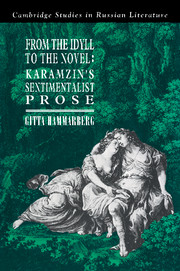Book contents
- Front Matter
- Contents
- Preface and acknowledgments
- Notes on the text
- 1 The literary and intellectual context
- 2 Theory of Sentimentalism
- 3 The literary model: the idyll
- 4 The extra-literary model: salon trifles
- 5 Serious Sentimental tales: narrator as narratee
- 6 Humorous Sentimental tales: narrator as parodist
- Notes
- Bibliography
- Index
4 - The extra-literary model: salon trifles
Published online by Cambridge University Press: 22 September 2009
- Front Matter
- Contents
- Preface and acknowledgments
- Notes on the text
- 1 The literary and intellectual context
- 2 Theory of Sentimentalism
- 3 The literary model: the idyll
- 4 The extra-literary model: salon trifles
- 5 Serious Sentimental tales: narrator as narratee
- 6 Humorous Sentimental tales: narrator as parodist
- Notes
- Bibliography
- Index
Summary
During the last quarter of the eighteenth century, literature changed to fit the new epistemologically oriented intellectual currents. The borders between literature and non-literature (‘life’ in the broad sense) were shifting: life entered art and what were previously regarded as facts of life, trivial from a literary point of view, now became sanctioned as literary facts. The literary legitimation of prose fiction, as we saw, was a case in point. The fictionalization of author/reader, i.e. the emergence of narrator/narratee as constitutive elements of narrative structure, was part of the same phenomenon. Partly this fictionalization was accomplished by drawing on existing literary genres which were still viable in terms of temporal, spatial, and axiological ‘fit’ to the era, namely the old middle genres, especially the idyll. Facts of life became aesthetic facts through ‘idyllization’. The idyllic chronotope as we have discussed it, was characterized by temporal, spatial, and axiological miniaturization, reduction, or, one might say, trivialization. ‘Less’ became ‘more’. Events, trifling from a literary point of view, such as promenades, botanical expeditions, simple pleasures, and good deeds, now became the prime literary topics. The topics became strongly personalized by a prominently featured vicariously or personally involved narrator and narratee cast in the idyllic mold.
Literary genres were, however, only one of the models for the new literature. Quasi-literary and even extra-literary speech genres became as important as the idyll and a great deal of ‘crossfertilization’ took place.
- Type
- Chapter
- Information
- From the Idyll to the NovelKaramzin's Sentimentalist Prose, pp. 93 - 127Publisher: Cambridge University PressPrint publication year: 1991



